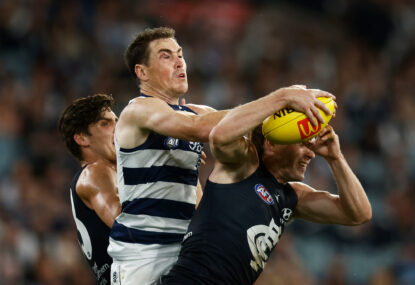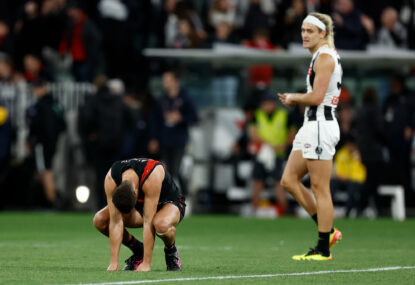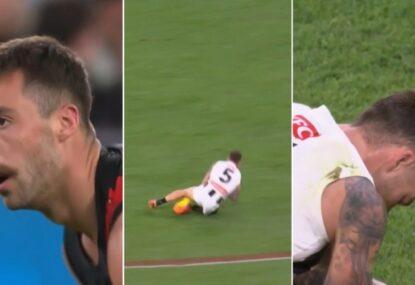After four rounds of the AFL season, trends begin to emerge and we can start to see a pattern as to what works and what doesn’t.
The 2019 campaign has seen two distinctive styles of play create the most success.
The lesser of the two has been a more reactionary approach, in which teams are satisfied to give up first possession in central stoppages, backing themselves in defensively to hold up strong and repel attacks, while applying immense pressure around the ground.
Geelong, Hawthorn and St Kilda have all produced impressive performances throughout the opening month of the season, largely on the back of a willingness to forgo possession in the middle in order to set up well defensively.
These teams are all in the top four for tackles in 2019, and all have conceded at least 42 inside-50s per game.
The issue with this tactic, however, is that it seemingly falls away against a mobile forward line, where the key talls are more athletic than one-on-one monsters.
A dynamic forward line like that of the Giants can create huge issues, given these types of teams are relying on intercept markers to mask the old-school key defenders that struggle to move around.
Arguably the most important player on any team in the opening month of 2019 has been the elite runner. Teams adopting a high kick-to-handball ratio and using their runners – formerly known as wingmen – have found the most definitive success within games.
It doesn’t surprise that Collingwood and West Coast – the two best teams of 2018 – are ranked highly in marks, and have continued to track as two of the better teams this season.
Andrew Gaff and Steele Sidebottom received many plaudits throughout last season for their work rate and effect on games, but the universal appreciation of that type of player never reached any great heights.
This season, however, has shone a light on the incredible value these elite running players can have. Anyone that has watched the two aforementioned clubs as well as GWS and to a lesser extent Brisbane would be able to see how important their outside players have been to the impressive starts.
Fremantle – although ranked lower in marks – also have a higher concentration of marks coming from their high work-rate players finding space as outlet options in between the defensive 35-40 metre zone and the centre circle.
Perhaps the season’s most impressive player has been Lachie Whitfield, who has been a key contributor to GWS’ success over the first month.
The 24-year-old is averaging 34 disposals with an incredible 79 per cent disposal efficiency, 10.5 marks and 678 metres gained.
As you can see in the official AFL heat map below, Whitfield has been able to get plenty of the ball on the half-back flank and on the wing, which has allowed GWS to exit out of defence and transition with ease.
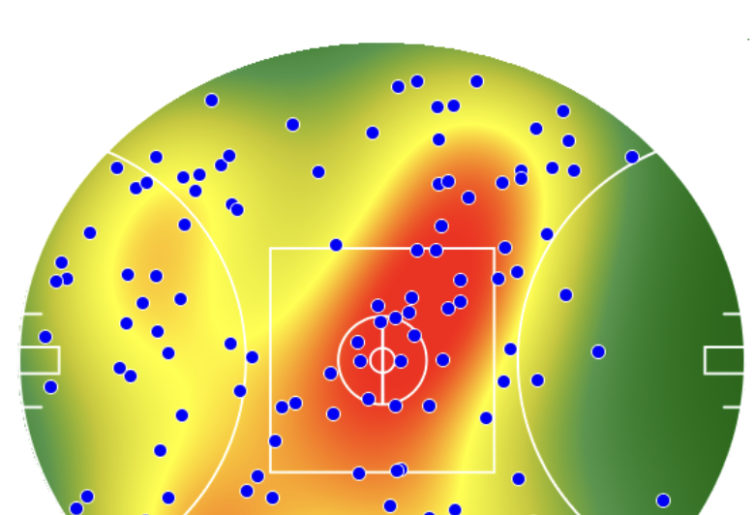
No outside player is able to receive the ball in more central positions than Whitfield, often coming from an initial mark as an outlet option before working harder than the opposition straight through the centre and launching scores from there.
The Giants are ranked third in the competition for both marks and running bounces, and it is largely on the back of Whitfield’s ability to create space on the ground for both him and his team-mates through sheer work rate.
Ed Langdon is one of the competition’s most underrated players and is a vital part of Fremantle’s exit strategy in 2019.
Following his breakout season in 2018, Langdon’s fitness has only further improved, which has allowed for him to push deeper into Fremantle’s defensive half to provide an outlet option for the defence, as pictured below in the AFL’s heat map.
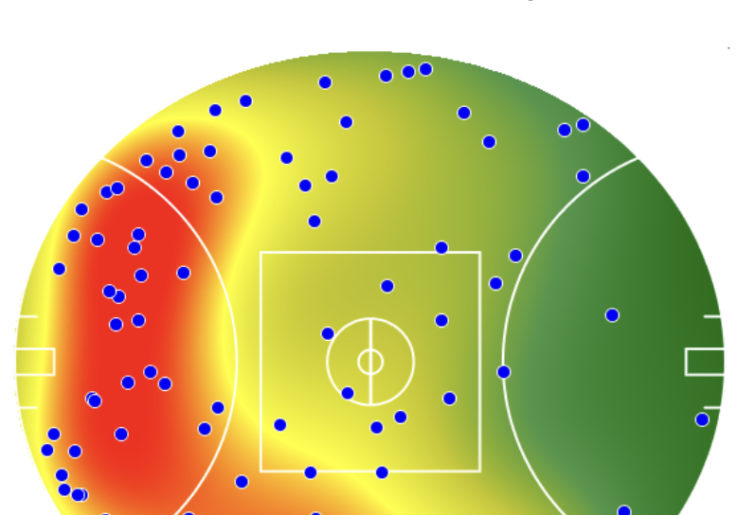
The Dockers have the luxury of playing two genuine stars as their main outside players, which has allowed for Langdon to take control of the defensive half, while Bradley Hill’s sole focus is to get the ball moving from an attacking position.
Langdon is averaging 27 disposals and seven marks per game, and is the one constant as Ross Lyon continues to try and mould Fremantle’s style into something more definitive.
The 23-year-old has committed a few too many turnovers but has often helped the Dockers to slow the game down by pushing back into defence.
Essendon’s Round 4 performance against Brisbane saw a marked improvement in the club’s ball movement and a more defined strategic performance.

(Photo by Dylan Burns/AFL Photos/Getty Images)
David Zaharakis was a key contributor on the wing with 30 disposals and ten marks playing a more familiar role, while Mitch Brown was the constant workhorse to capitalise on the open space in between the arcs, finishing with 11 marks and 14 of his possessions collected on the wing.
More and more, teams are figuring out that the best way to transition the ball out of defence is to rely upon these outside players, who tend to create space with their running patterns, rather than bashing the ball directly through the middle every time, or trying to consistently tackle their way to victory.
As the season continues to play out, we will continue to find that the breakout stars of the competition will all be the players clubs heavily rely upon to find space to provide the defence with an outlet option, and those who can outrun the opposition.
Come mid-season, we will have heard more about Jack Billings (averaging 30 disposals and five marks), Ryan Burton (23 disposals, nine marks in Round 4) and Hugh McCluggage (averaging 20 disposals and five inside-50s), highlighting how important they have been to their clubs.
We can expect to hear more about how Hawthorn uses Ricky Henderson more than Isaac Smith and Tom Scully as the conduit between defensive transition and attacking results, while Richmond seems to have finally found out that Brandon Ellis can form a dangerous duo with Kane Lambert through the wider midfield areas.
Teams no longer need to rely on outside players to solely ply their trade on the wing.
The importance of Sidebottom, Gaff and Whitfield can be felt all over the ground, and it’s that evenly spread heat map mixed with plenty of uncontested marks that makes up the perfect player in 2019.
Despite the 6-6-6 rule, the game is as fluid as ever.
There is no more exclusivity in positioning on the outside, and the clubs willing to invest highly on-field with their elite runners will experience the most success.
































































































